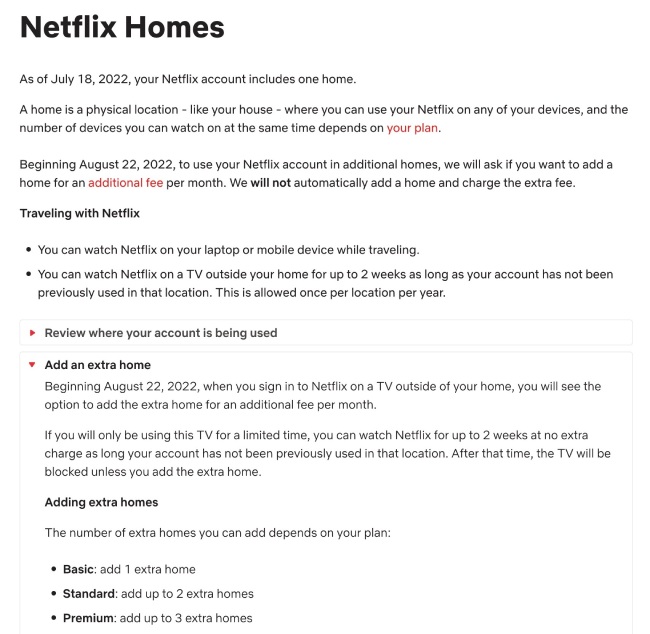When Netflix introduced a “extra home” fee for those who share accounts with people they don’t live with four months ago, it started to tighten down on password sharing. In Chile, Costa Rica, and Peru, an additional $2–$3 per month membership cost was introduced. Netflix stated that it will assess the rollout before making any modifications in other nations.
This week’s Monday brought news of a new price that Netflix would impose on users who share accounts. Starting on August 22, customers in Argentina, the Dominican Republic, El Salvador, Guatemala, and Honduras would be taxed for “extra homes” under the new one.
“Beginning August 22, 2022, if your Netflix account is being used on a TV outside of your home, you will need to pay an extra $2.99 per month for each extra home. You will only be charged when you or someone who uses your account chooses to add an extra home—this fee will NOT be automatically charged, ” On its pricing page for Honduras, Netflix states.
Additionally, in Guatemala, El Salvador, and the Dominican Republic, there is a $2.99 monthly charge for each additional house. The cost is 219 pesos ($1.70 USD) each month in Argentina. By the end of the year, Netflix is reportedly seeking to push out an account-sharing fee or tariffs more broadly.
Netflix has not specified whether it will standardise on a single fee, give users the option of the extra home or extra member fees, or come up with another option for the anticipated global rollout. According to the company’s release from yesterday, Netflix wants to “to be as thoughtful as possible about how we charge for use across multiple homes” and “will not make changes in other countries until we better understand what’s easiest for our members.”
In addition to the streamer’s existing ad-free offerings, Netflix also intends to develop an ad-supported tier as its revenue growth slows.
If you don’t add the extra home, TV will be blocked
A “Users can “can watch Netflix on your laptop or mobile device while traveling,” according to the “Netflix Homes” FAQ, and they can “watch Netflix on a TV outside your home for up to two weeks as long as your account has not been previously used in that location. This is allowed once per location per year.”
Beginning August 22, users who log in from a location other than their home “will get the opportunity to add the extra house for an additional charge per month” or take advantage of the two-week grace period, according to Netflix. As you can see in this screenshot, the Netflix FAQ earlier today contained the following sentence: “the TV will be blocked unless you add the extra home.”


Although the part regarding blocking TVs has been removed, it is still obvious that users must pay the charge to prevent being blocked in other people’s houses. According to Netflix, it uses “information such as IP addresses, device IDs, and account activity” to identify extra households. Make sure “the device is not connected to a VPN, proxy, or any unblocker service,” Netflix warns users, to avoid alerts that state “too many homes are using your account.”
Users will be able to “review which TV or TV-connected devices are using your account by location, and sign out your account from a location,” according to a new feature added by Netflix to user account pages. When a location is signed out, all connected devices are also signed out.
Depending on their subscription plan, Netflix will set a cap on the number of additional houses that consumers can add. One additional home may be added by a Basic plan subscriber, two new homes may be added by a Standard plan subscriber, and three additional homes may be added by a Premium plan user.
In the Dominican Republic, El Salvador, Guatemala, and Honduras, the monthly costs for Netflix’s Basic, Standard, and Premium plans range from $7.99 to $13.99. In the US, the costs range from $9.99 to $19.99. The various tiers have pre-set limits on the number of viewers who can watch at once, however these restrictions are based on the number of displays rather than the number of locations.
- Cougars Coach Kelvin Sampson Chases 800th Career Victory in NCAA Finals - April 8, 2025
- How to Check IIT GATE 2025 Results Online? Complete Guide - March 19, 2025
- Deadmau5 Sells Song Catalog for $55M to Launch New Music Venture - March 6, 2025


